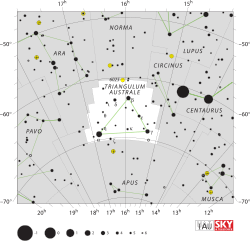Gamma Trianguli Australis

| |
| Observation data Epoch J2000.0 Equinox J2000.0 | |
|---|---|
| Constellation | Triangulum Australe |
| Right ascension | 15h 18m 54.58198s[1] |
| Declination | –68° 40′ 46.3654″[1] |
| Apparent magnitude (V) | +2.87[2] |
| Characteristics | |
| Spectral type | A1 V[3][4] |
| U−B color index | –0.02[5] |
| B−V color index | +0.00[5] |
| Astrometry | |
| Radial velocity (Rv) | –3.0[2] km/s |
| Proper motion (μ) | RA: –66.58[1] mas/yr Dec.: –32.31[1] mas/yr |
| Parallax (π) | 17.74 ± 0.12[1] mas |
| Distance | 184 ± 1 ly (56.4 ± 0.4 pc) |
| Details | |
| Radius | 5.86[6] R☉ |
| Temperature | 9,400[6] K |
| Rotational velocity (v sin i) | 199[4] km/s |
| Age | 260[7] Myr |
| Other designations | |
Gamma Trianguli Australis (γ TrA, γ Trianguli Australis) is a star in the constellation Triangulum Australe. Along with Alpha and Beta Trianguli Australis it forms a prominent triangular asterism that gives the constellation its name (Latin for southern triangle). It is the third-brightest member of this constellation with an apparent visual magnitude of +2.87.[2] based upon parallax measurements, Gamma Trianguli Australis is located at a distance of about 184 light-years (56 parsecs) from Earth.[1]
The spectrum of this star matches a stellar classification of A1 V,[3][4] which identifies it as an A-type main sequence star that is generating energy through the nuclear fusion of hydrogen at its core. An unusual abundance of the element europium demonstrates it to be a peculiar, or Ap star.[9] Most stars of this type are slow rotators,[10] but Gamma Trianguli Australis displays a very high rate of rotation with a projected rotational velocity of 199 km s−1.[4] It has an estimated age of 260 million years.[7]
This system shows an excess emission of infrared radiation, suggesting that there is a circumstellar disk of dust orbiting this star. The mean temperature of the emission is 50 K, corresponding to a separation from the star of 481 astronomical units.[6]
Modern legacy
γ TrA appears on the flag of Brazil, symbolising the state of Paraná.[11]
References
- 1 2 3 4 5 6 van Leeuwen, F. (November 2007), "Validation of the new Hipparcos reduction", Astronomy and Astrophysics, 474 (2): 653–664, arXiv:0708.1752
 , Bibcode:2007A&A...474..653V, doi:10.1051/0004-6361:20078357
, Bibcode:2007A&A...474..653V, doi:10.1051/0004-6361:20078357 - 1 2 3 Wielen, R.; et al. (1999), Sixth Catalogue of Fundamental Stars (FK6). Part I. Basic fundamental stars with direct solutions (35), Astronomisches Rechen-Institut Heidelberg, Bibcode:1999VeARI..35....1W
- 1 2 Levato, O. H. (August 1972), "Rotational Velocities and Spectral Types of Some A-Type Stars", Publications of the Astronomical Society of the Pacific, 84 (500): 584, Bibcode:1972PASP...84..584L, doi:10.1086/129336
- 1 2 3 4 Royer, F.; Zorec, J.; Gómez, A. E. (February 2007), "Rotational velocities of A-type stars. III. Velocity distributions", Astronomy and Astrophysics, 463 (2): 671–682, arXiv:astro-ph/0610785
 , Bibcode:2007A&A...463..671R, doi:10.1051/0004-6361:20065224
, Bibcode:2007A&A...463..671R, doi:10.1051/0004-6361:20065224 - 1 2 Johnson, H. L.; et al. (1966). "UBVRIJKL photometry of the bright stars". Communications of the Lunar and Planetary Laboratory. 4 (99). Bibcode:1966CoLPL...4...99J.
- 1 2 3 Rhee, Joseph H.; et al. (May 2007), "Characterization of Dusty Debris Disks: The IRAS and Hipparcos Catalogs", The Astrophysical Journal, 660 (2): 1556–1571, arXiv:astro-ph/0609555
 , Bibcode:2007ApJ...660.1556R, doi:10.1086/509912
, Bibcode:2007ApJ...660.1556R, doi:10.1086/509912 - 1 2 Rieke, G. H.; et al. (February 2005), "Decay of Planetary Debris Disks", The Astrophysical Journal, 620 (2): 1010–1026, Bibcode:2005ApJ...620.1010R, doi:10.1086/426937
- ↑ "gam TrA -- Variable Star", SIMBAD Astronomical Object Database, Centre de Données astronomiques de Strasbourg, retrieved 2012-02-04
- ↑ Sokolov, N. A. (June 1998), "Effective temperatures of AP stars", Astronomy and Astrophysics Supplement, 130: 215–222, Bibcode:1998A&AS..130..215S, doi:10.1051/aas:1998226
- ↑ Abt, Helmut A.; Morrell, Nidia I. (July 1995), "The Relation between Rotational Velocities and Spectral Peculiarities among A-Type Stars", Astrophysical Journal Supplement, 99: 135, Bibcode:1995ApJS...99..135A, doi:10.1086/192182
- ↑ "Astronomy of the Brazilian Flag". FOTW Flags Of The World website.